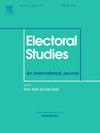With a little help from the crowd: Estimating election fraud with forensic methods
IF 2.3
2区 社会学
Q1 POLITICAL SCIENCE
引用次数: 0
Abstract
Election forensics are a widespread tool for diagnosing electoral manipulation out of statistical anomalies in publicly available election micro-data. Yet, in spite of their popularity, they are only rarely used to measure and compare variation in election fraud at the sub-national level. The typical challenges faced by researchers are the wide range of forensic indicators to choose from, the potential variation in manipulation methods across time and space and the difficulty in creating a measure of fraud intensity that is comparable across geographic units and elections. This paper outlines a procedure to overcome these issues by making use of directly observed instances of fraud and machine learning methods. I demonstrate the performance of this procedure for the case of post-2000 Russia and discuss advantages and pitfalls. The resulting estimates of fraud intensity are closely in line with quantitative and qualitative secondary data at the cross-sectional and time-series level.
在群众的帮助下:用法医方法估计选举舞弊
选举取证是一种广泛使用的工具,用于从公开的选举微观数据的统计异常中诊断选举操纵。然而,尽管它们很受欢迎,但它们很少被用来衡量和比较地方选举舞弊的变化。研究人员面临的典型挑战是可供选择的法医指标范围广泛,操纵方法在时间和空间上的潜在变化,以及难以创建跨地理单位和选举可比较的欺诈强度衡量标准。本文概述了通过使用直接观察到的欺诈实例和机器学习方法来克服这些问题的程序。我将以2000年后的俄罗斯为例演示该程序的性能,并讨论其优点和缺陷。由此产生的欺诈强度估计与横截面和时间序列水平上的定量和定性二手数据密切一致。
本文章由计算机程序翻译,如有差异,请以英文原文为准。
求助全文
约1分钟内获得全文
求助全文
来源期刊

Electoral Studies
POLITICAL SCIENCE-
CiteScore
3.40
自引率
13.00%
发文量
82
审稿时长
67 days
期刊介绍:
Electoral Studies is an international journal covering all aspects of voting, the central act in the democratic process. Political scientists, economists, sociologists, game theorists, geographers, contemporary historians and lawyers have common, and overlapping, interests in what causes voters to act as they do, and the consequences. Electoral Studies provides a forum for these diverse approaches. It publishes fully refereed papers, both theoretical and empirical, on such topics as relationships between votes and seats, and between election outcomes and politicians reactions; historical, sociological, or geographical correlates of voting behaviour; rational choice analysis of political acts, and critiques of such analyses.
 求助内容:
求助内容: 应助结果提醒方式:
应助结果提醒方式:


